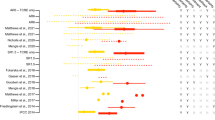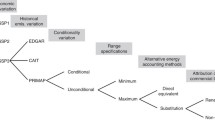Abstract
The focus of this study is on the preparatory detection of uncertain greenhouse gas (GHG) emission changes (also termed emission signals) under the Kyoto Protocol. Preparatory signal detection is a measure that should be taken prior to/during negotiation of the Protocol. It allows the ranking of countries under the Protocol according to their realized versus their agreed emission changes and in terms of both certainty and credibility. Controlling GHGs is affected by uncertainty and may be costly. Thus, knowing whether each nation is doing its part is in the public interest. At present, however, countries to the United Nations Framework Convention on Climate Change (UNFCCC) are obliged to include in the reporting of their annual inventories direct or alternative estimates of the uncertainty associated with these, consistent with the Intergovernmental Panel on Climate Change’s (IPCC) good practice guidance reports. As a consequence, inventory uncertainty is monitored, but not regulated, under the Kyoto Protocol. Although uncertainties are becoming increasingly available, monitored emissions and uncertainties are still dealt with separately. In our study we analyze estimates of both emission changes and uncertainties to advance the evaluation of countries and their performance under the Protocol. Our analysis allows supply and demand of emissions credits to be examined in consideration of uncertainty. For the purpose of our exercise, we make use of the Undershooting and Verification Time concept described by Jonas et al. (Clim Change doi:10.1007/s10584-010-9914-6, 2010).
Similar content being viewed by others
References
Arena-Eco (2006) Ukrainian national inventory report 1990–2004. Arena-Eco, Kiev, Ukraine (in Russian)
Bun R et al (2010) Spatial GHG inventory at the regional level: accounting for uncertainty. Clim Change. doi:10.1007/s10584-010-9907-5
Canadell P, Ciais P, Conway T, Field C, Le Quere C, Houghton S, Marland G, Raupach M, Buitenhuis E, Gillett N (2007) Recent carbon trends and the global carbon budget update to 2006. Global Carbon Project. http://www.globalcarbonproject.org/global/ppt/GCP_CarbonCycleUpdate.ppt
EEA (2006) Annual European community greenhouse gas inventory 1990–2004 and inventory report 2006. Technical Report No 6, European Environment Agency (EEA), Copenhagen Denmark. http://reports.eea.europa.eu/technical_report_2006_6/en/
Gillenwater M, Sussman F, Cohen J (2004) Practical applications of uncertainty analysis for national greenhouse gas inventories. GHG Uncertainty Workshop, Warsaw, p 14
Hamal KH, Jonas M (2008) Preparatory signal detection for the EU-27 member states under EU burden sharing—advanced monitoring including uncertainty (1990–2005). Interim Report IR-08-037, International Institute for Applied Systems Analysis, Laxenburg, Austria, pp 51. http://www.iiasa.ac.at/Admin/PUB/Documents/IR-08-037.pdf
IPCC (1997) Revised 1996 IPCC guidelines for national greenhouse gas inventories: reporting instructions. The workbook reference manual, vols 1–3. Intergovernmental Panel on Climate Change (IPCC) Working Group I (WG I) Technical Support Unit, Bracknell, United Kingdom. http://www.ipcc-nggip.iges.or.jp/public/gl/invs4.htm
IPCC (1998) The IPCC software for estimating greenhouse gas emissions. IPCC version 1. http://www.ipcc-nggip.igres.or.jp/public/gl/software.htm
Jonas M, Nilsson S, Bun R, Dachuk V, Gusti M, Horabik J, Jęda W, Nahorski Z (2004) Preparatory signal detection for Annex B countries under the Kyoto Protocol—a lesson for the post-Kyoto policy process. Interim Report IR-04-024, International Institute for Applied Systems Analysis, Laxenburg, Austria, p 91. http://www.iiasa.ac.at/Publications/Documents/IR-04-024.pdf
Jonas M et al (2010) Comparison of preparatory signal analysis techniques for consideration in the (post-) Kyoto policy process. Clim Change. doi:10.1007/s10584-010-9914-6
Nahorski Z, Horabik J, Jonas M (2007) Compliance and emissions trading under the kyoto protocol: rules for uncertain inventories. Water Air Soil Pollut: Focus 7(4–5):20
Nahorski Z et al (2010) Compliance and emission trading rules for asymmetric emission uncertainty estimates. Clim Change. doi:10.1007/s10584-010-9916-4
Roshydromet (2006) National report on anthropogenic GHG emissions and sinks of 2002–2004. Federal Service for Hydrometeorology and Environment Monitoring (Roshydromet), Moscow, Russia, pp 139 [in Russian]
USEPA (2006) Inventory of US greenhouse gas emissions and sinks: 1990–2004. US Environmental Protection Agency, Washington DC, pp 448
Author information
Authors and Affiliations
Corresponding author
Rights and permissions
About this article
Cite this article
Bun, A., Hamal, K., Jonas, M. et al. Verification of compliance with GHG emission targets: annex B countries. Climatic Change 103, 215–225 (2010). https://doi.org/10.1007/s10584-010-9906-6
Received:
Accepted:
Published:
Issue Date:
DOI: https://doi.org/10.1007/s10584-010-9906-6




